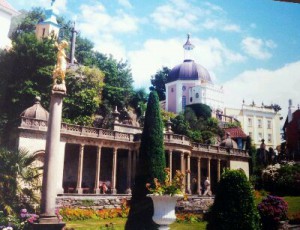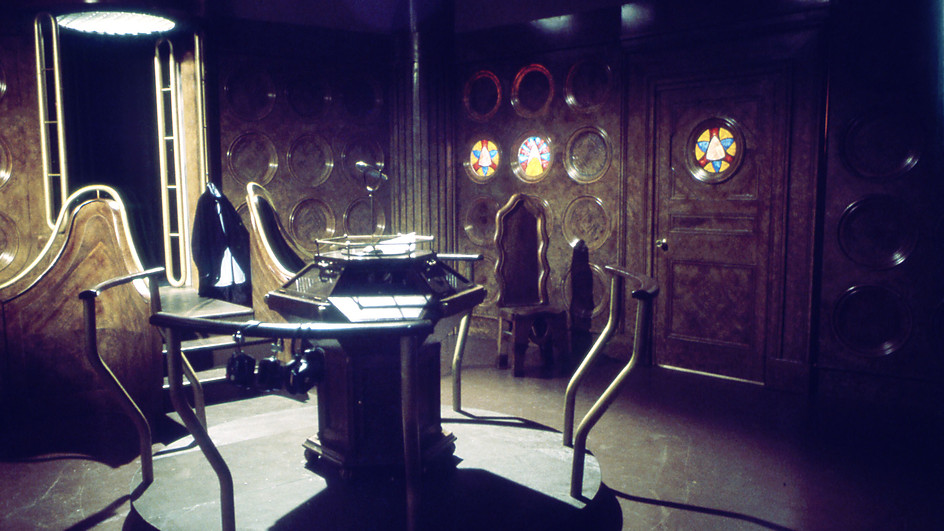 Season 14 opens with one of the lesser outings for this era of Dr Who, but here in the midst of the Golden Age that’s barely a criticism: it’s still a great episode I wouldn’t hesitate to show any non-fan looking for an introduction. It’s a “pseudo-historical” set in Renaissance Italy, and among other things it looks absolutely beautiful. This sort of period/costume drama is exactly the kind of thing the BBC excels at, even on Dr Who’s miniscule budget, and the sets and costumes are detailed and wonderful, while the episode takes full advantage of a location that convincingly looks like they actually filmed in Italy somewhere. (They didn’t: see the picture above? It’s a town in Wales.)
Season 14 opens with one of the lesser outings for this era of Dr Who, but here in the midst of the Golden Age that’s barely a criticism: it’s still a great episode I wouldn’t hesitate to show any non-fan looking for an introduction. It’s a “pseudo-historical” set in Renaissance Italy, and among other things it looks absolutely beautiful. This sort of period/costume drama is exactly the kind of thing the BBC excels at, even on Dr Who’s miniscule budget, and the sets and costumes are detailed and wonderful, while the episode takes full advantage of a location that convincingly looks like they actually filmed in Italy somewhere. (They didn’t: see the picture above? It’s a town in Wales.)
The story: the evil “Mandragora Helix,” a kind of disembodied intelligence made of cosmic energy, hijacks the TARDIS to hitch a lift to 15th century Italy. Mandragora doesn’t like the idea of how far humans may one day progress and plans to call off the Renaissance by helping a revived pagan cult murder all the greatest scholars and artists of the age, who have gathered together for a Masque celebrating the accession of the young, idealistic Duke Guliano. There are royal intrigues afoot between the Duke and his villainous uncle who is plotting to seize the throne, while the real threat of the cult and Mandragora builds gradually— rather like last week’s story, a story of purely human villains and good guys holds center stage while the alien threat lurks on the sidelines until the climax.
Once again Dr Who of this era pays tribute to a classic horror movie, in this case Vincent Price in “The Masque of the Red Death,” and once again develops its own entirely new story drawing inspiration, but not plot points, from its source. It’s a formula that works time and again for Dr Who and it works again here. Mandragora and its cultists are not quite as thrilling as some other recent villains, and the young Duke is a rather weak character (but his loyal friend and aide Marco makes up for it) but the villainous Count Frederico is a marvelous mustache-twirling villain (even though he doesn’t have a mustache) and the gorgeous visuals make the story a pleasure to watch.
Details
- It’s surprising to realize how rarely Dr Who visited Earth’s past once the “true historicals” were dropped after the end of William Hartnell’s tenure on the show. “The War Games” and “Carnival of Monsters” had scenes that appeared to take place in the past but were quickly revealed to be something else. “The Abominable Snowmen” was ostensibly set in the 1930s but took place entirely at a Tibetan monastery without any real historical connection (you could easily imagine the monastery being exactly the same today). In fact before this episode I can think of only two visits to the past since the last straight historical: “The Time Warrior” with Jon Pertwee, and last season’s “Pyramids of Mars.” Other than that it’s been either Earth’s present, an alien planet, or some variety of Buck Rogers future. It was the success of “Pyramids of Mars” that convinced Philip Hinchcliffe that historical settings could work even with a science fiction/alien threat. There will be more of them going forward.
- Speaking of success, episode 3 of “The Masque of Mandragora” had the highest ratings in the history of the Classic series (according to a book published to commemorate the 20th anniversary back in 1983– it’s unlikely that any post-1983 Classic ever beat the record, though I haven’t seen any article taking up the question).
- The TARDIS gets a makeover to start season 14, inside and out. Both the console room and the police box prop were the same ones that had been used since the very first episode in 1963, so an overhaul was overdue. Taking each in turn:
- The police box: the original wooden prop had been battered, repainted, and occasionally sawn in two to fit it into sets where it just couldn’t fit on its own. Between deliberate modifications, and repairs that just didn’t pay attention to how it looked before, it had gone through a great many small changes of detail along the way, but it was still the original prop. By the start of season 14 it was clear that a new one was needed. The designer for Mandragora, Barry Newbery, built a new police box prop, introducing design changes specifically meant to address the problems the old prop had caused. Sharp-eyed fans noticed the difference and the Newbery TARDIS, which would be used for the next four seasons, gets a lot of criticism from the kind of fan who thinks that kind of thing is worth criticizing. On the other hand, most fans won’t notice a difference. Now that I’ve told you about it, you can have some fun by putting this story side by side with one from last year and playing “spot the differences.”
- The console room: with the exception of the unpopular “mixing bowls stuck to the walls” set that was tried for one episode (“The Time Monster”) during Pertwee’s run, the console room was also the original set from 1963, though in this case you’d never know it. The console room seen in the pilot episode was an immense set, and ever since then only pieces of it were seen. Since it had to be disassembled when not in use (Classic Dr Who never had its own studio space where standing sets could remain), the various flats that made up the set were often put together in different arrangements, or lighted differently, making up console rooms of differing sizes and appearances. But again, it was all done with the original set pieces and they also were showing their age. Hinchcliffe asked Newbery to design an entirely new console room, one that would be much smaller than the original. Newbery went with a wood-paneled, brass-railed room like an old British gentleman’s club, and a very small central console patterned after a Victorian writing desk (as an eccentric touch fitting the Doctor, one of the 6 faces of the console actually has writing materials rather than controls). There’s no time rotor in the center of the console, but there is a shaving mirror there for some reason. For the first time, the scanner is not a monitor hanging from the ceiling but a screen built into the wall (its images from now on will be done with chromakey rather than using an actual on-set monitor picture).
- Though a good deal smaller than the original, the set looks larger— partly because it’s not all white plastic but mostly because since 1963 they’d hardly ever used more than a single corner of the original at one time.
- Moving from behind-the-scenes to on screen: we get to see the Doctor and Sarah wandering around inside the TARDIS, a thrill for any fan since we haven’t been allowed past the console room since the first season. Sarah passes what looks like an immense ballroom or something with a pair of Wellington boots right by the door, which the Doctor says is the boot cupboard. Finding the wood-paneled console room, the Doctor says it’s the old one. Perhaps to soften the change, one of the Third Doctor’s costumes is gathering dust in one corner and one of the Second’s can be seen in another. Sarah finds the Second Doctor’s recorder and plays a few notes on it.
- Interestingly, after the Doctor uses the controls in the new “old” console room, going out its main door leads to the outside, and when the Doctor and Sarah go back into the TARDIS they arrive back there rather than in the original console room— the first indication the series has given that the TARDIS interior can be reconfigured on the fly.
Next Week:
“The Hand of Fear”: 4 episodes, and brace yourself because something big will happen at the end of it.


